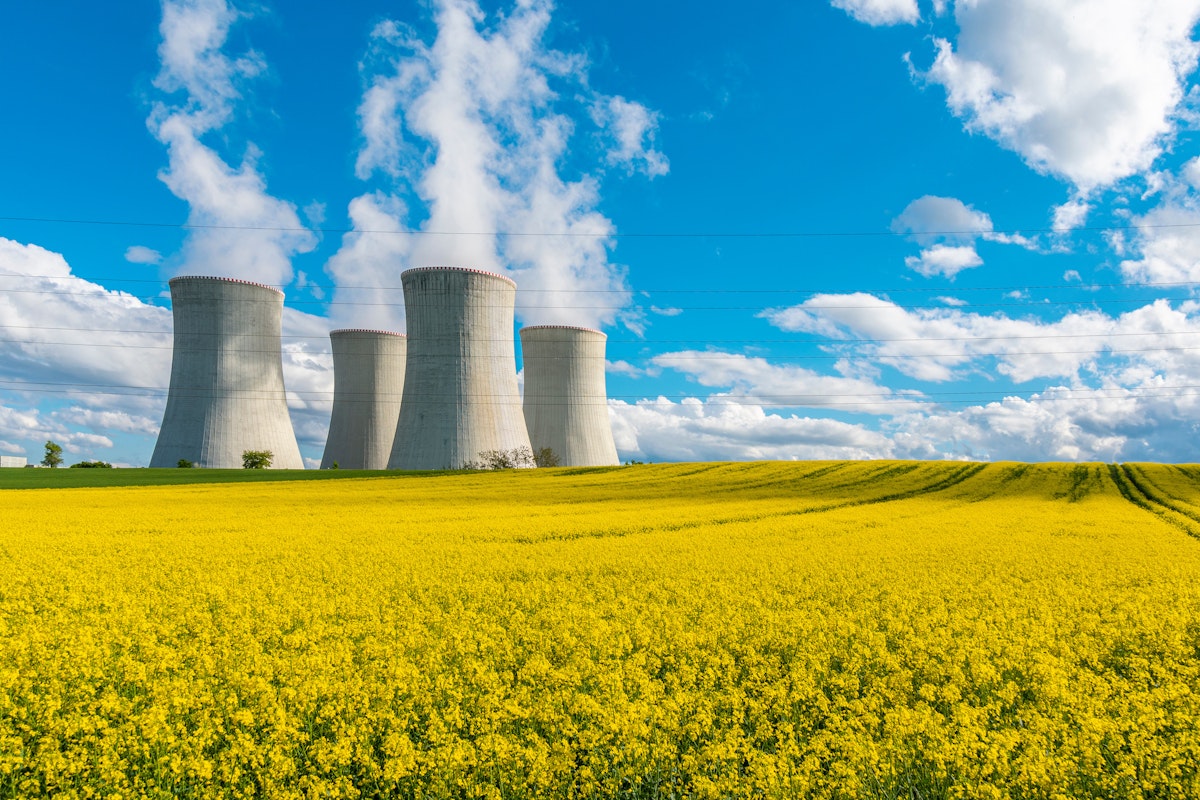It's Settled, More Nuclear Energy Means Less Mining
Clean Energy Minerals Are Challenging Traditional Environmental Dogmas

-
-
Share
-
Share via Twitter -
Share via Facebook -
Share via Email
-
For decades, the environmental movement has lumped nuclear energy with fossil fuels as a mining-intensive, environmentally destructive technologies while extolling solar and wind as pillars of a more sustainable future.
“Nuclear energy is a carbon hog. Plant construction cement, steel, and complex electronics is carbon intensive” opines Greenpeace co-founder Rex Wyler in one rambling essay. Another report by Friends of the Earth condemns mining for nuclear fuel as unacceptable, while exonerating mining for solar and wind as worrying but manageable in the next breath. A graphic produced by the Japanese environmental think tank Climate Integrate groups nuclear power and mining under an unequal fossil-fuel system while enshrining wind and solar within an “equal” and “nature positive” future society, somehow blissfully separated from mineral production.
Claiming that nuclear power is more mining-intensive than renewables never made much sense to begin with, but such assertions have stubbornly persisted in environmental forums, simply because nobody had invested the effort into challenging them with modern data.
That debate is now settled. When considering how to best manage the mining footprint of a global shift to low-carbon energy, the math clearly shows that clean energy systems using relatively more nuclear energy will impose fewer mining impacts than systems using only solar, wind, and storage. A major research report from my team, building on recent U.S. National Renewable Energy Laboratory, MIT, and United States Geological Survey analyses, finds that every unit of clean electricity from a nuclear power plant requires excavating just 30% or 23% the mass of rock and metal, compared to an equal unit of solar or onshore wind electricity.
But many traditional environmentalists and nuclear technology opponents remain determined to exclude clean nuclear power from consideration as a clean energy source by any means necessary. However, using mining as an angle of attack to label nuclear energy as “not sustainable” relative to solar and wind is to make arguments utterly unmoored from real-world data. Rather, insisting on a renewables-only nuclear-free energy system means accepting higher mining-related environmental tradeoffs. Anti-nuclear environmental thinkers must either grapple with that tension or embrace it, but they cannot deny it.
After the clean tech mining arguments
I do have some good news—both for wind and solar advocates and for all pragmatic environmentalists. First, blanket demonization of mining as a concept is misguided to begin with, given mining’s necessity to modern society and for global human development. Second, the extractive intensity of any clean energy system will likely prove considerably better than our existing fossil-based energy system, given the gargantuan scale of coal mining globally. Third, the mining impacts of solar, wind, or nuclear energy are flexible, not fixed, and can improve significantly as technology and practices advance.
To the pragmatic technological optimist, the moderately higher mining footprint of solar and wind energy is just one of many variables in the calculus and politics of achieving a better future, one in which society will probably employ both renewable and nuclear technologies together.

Rather, the harshest rebuke from this data-driven discussion of clean energy mineral needs falls upon entrenched, incoherent environmental dogmas. International green groups and decorated sustainability scholars cannot claim to worship at the altar of empirical science while invoking the material footprint of nuclear energy to classify it “unsustainable”. Nor are calls from degrowth, ecosocialist, or traditional environmentalists to limit extraction through unrealistic and convoluted social measures logically reconcilable with their continued rejection of nuclear power’s potential to alleviate the mining impacts of the clean energy transition.
In one prominent example, the treatise A Planet to Win devotes thirty-odd pages to the importance of reducing energy demand, slashing car dependence, recycling more, restricting the global mining industry, and even supporting resistance at “mines linked to renewable energy” to “buy time” for better mining and recycling technologies (essentially blockading clean energy mineral production) as part of the authors’ vision for a Global Green New Deal. Yet the book’s only mention of nuclear power is a gesture of lukewarm support for running existing nuclear plants a little longer… until society can replace them with solar and wind.
It is time for climate commentators to acknowledge that nuclear technology could in fact aid the advancement of many of their fundamental aims—and in doing so begin the necessary work of rethinking their environmental worldviews in more ecomodernist terms.
At the very least, environmentalists must acknowledge the inherent tradeoffs of insisting on 100% renewable energy systems. The last 10% of an ultimately subjective 100% renewable grid aspiration not only comes with high and nonlinear cost increases from the additional solar, wind, and storage resources to cover all needs at all times and in all weather, but also necessitates greater land and mining footprints. Energy systems with high shares of wind and solar also require more geographically distributed infrastructure like transmission, substations, synchronous condensers, distribution upgrades, and more—important additional mineral demand drivers that our recent study does not capture. Producing low-carbon fuels like hydrogen, methanol, or renewable synthetic methane for use in power plants, vehicles, or industry would require yet even more expansive deployment of renewables and storage to power the requisite electrolyzers and carbon capture facilities.
The match between nuclear and better mining is strong
Some environmental commentators would counter that society will ultimately supply new solar, wind, and battery equipment through recycling rather than new mining. While this is possible in the long-term, the limited availability of many recycled materials like silver, rare earth elements, lithium, or graphite makes this infeasible in the near-term. Moreover, improved recycling would benefit nuclear technology equally if not more, enabling reactors not only built with repurposed steel and concrete aggregate but also powered with recycled spent fuel.
Others might emphasize that the avoided coal mining from a clean energy transition is so substantial that the relative differences in the mining footprint of nuclear, wind, or solar are minor and negligible by comparison. This argument has some merit, but falters somewhat upon considering important nuances.
First, coal-fired electricity is already diminishing, extinct, or was nonexistent to begin with in many regions like Western Europe, California, the Middle East, or much of South America. Coal mining impacts are entirely irrelevant to the mining-related implications of the energy transition in these regions, which are effectively choosing between renewables, gas, and nuclear (and oil in the case of the Middle East). Coal of course remains a factor in other regions like Eastern Europe, East Asia, India, Australia, or Southeast Asia.
Second, mining for clean energy minerals is often more additional to coal mining than it is substitutional. Coal is a consumable fuel, not a metal, so society has already incurred all of the coal mining impacts for the coal energy historically produced to date. Much—though certainly far from all—of current and future coal demand will also be supplied from existing mines and regions. Those mines would correspondingly expand even as the required rate of global supply shrinks, consuming more land in the process, but the global geography of coal mining will not likely shift as dramatically as that of the critical minerals sector in the decades to come. The energy transition, in contrast, will bring new mines to mostly new places, impacting new ecosystems and creating new sociopolitical tensions. Such regional dynamics can get overlooked when considering changes in global average mining activity only.

Lastly, environmentalists and progressives would themselves challenge society not to contentedly accept a future that only offered moderate improvements from the present day when even greater gains are reasonably possible. All else equal, future energy systems that incorporate more nuclear power alongside renewables will consume less land directly, and less land through mining.
At the same time avid pro-nuclear supporters should not leap too quickly to condemn renewable energy as a mining nightmare. Too often, debate over nuclear and renewables originates out of technological pessimism over allegedly inherent, insurmountable problems that society and technology can actually overcome in practice. Nuclear proponents dismiss wind and solar as sprawling, short-lived infrastructure while nuclear opponents bemoan nuclear energy costs and safety risks. But none of these characteristics are ironclad axioms.
One can imagine thinner, more efficient futuristic solar panels that last for half a century, just as one can imagine affordable factory-produced nuclear reactors with inventive, foolproof safety features. A rigorous ecomodernist and technological optimist imagines both sets of technologies at their best, distinguishes between solvable problems and truly inherent characteristics, and works determinedly to crack the former.
The long lever of innovation
But even if traditional and radical environmentalists remain hesitant to contemplate ecomodernism, it may be time for them to reconsider their stubborn opposition to nuclear energy. Indeed, the challenging nexus of clean energy minerals and the energy transition arguably reveals underlying fissures and incoherencies within both traditional environmentalism and its modern offshoots like ecosocialism and degrowth communism. The key driver for maximizing human well-being and minimizing the impacts of mining upon nature is clearly technological innovation and decoupling, not societal behavior change.
With current technology, nuclear energy would do more to reduce energy transition mining than degrowth ideas like rationing ever could. Looking forward into the future, it is far easier to cut the amount of aluminum in solar farms by half than it would be to cut the amount of solar panels needed globally by half. Innovative approaches for isolating magnesium from seawater could replace aluminum solar module frames with virtually no future mining whatsoever. And even degrowth and circular economy proponents cannot avoid invoking significant future advances in recycling technology that will require some time yet to materialize. While degrowth writers might rush to cite material efficiency gains and recycling improvements as evidence that they also do support technological solutions, this ultimately amounts to drawing the same tired, arbitrary boundaries around “good” and “bad” technologies.
Indeed, the act of mining new metals itself has produced immeasurable good throughout ancient and modern human history and is hardly inherently sinful. The key metric for society to manage is not the quantity of metals pulled out of the ground, but rather the tonnage of moved earth, the change in water quality, the amount of airborne dust and carbon, and the fair sharing of the profound benefits to civilization that those metals produce. Good governance and technological advances can improve all of these metrics.
The point of highlighting differences in mining footprints between energy sources is not that we should build only nuclear energy, that we should limit the amount of energy we consume, or that we should restrict the quantity of renewables we build. Instead, we should continue to use all the tools at our disposal to meet future energy needs with fewer and fewer minerals and environmental impacts. The foundation for this approach is the ability to imagine how technologies can continue to advance individually and in concert. Mounting support for nuclear power in many parts of the world is one of many promising signs that such thinking is already gaining momentum.


